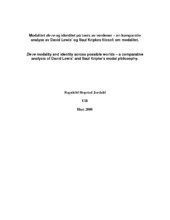Modalitet de re og identitet på tvers av verdener – en komparativ analyse av David Lewis’ og Saul Kripkes filosofi om modalitet
Master thesis
Permanent lenke
https://hdl.handle.net/1956/4479Utgivelsesdato
2008-11-19Metadata
Vis full innførselSamlinger
- Department of Philosophy [240]
Sammendrag
This paper is concerned with modality de re, and how possible worlds best represents this kind of modality. There are mainly two different ways for possible worlds to represent modality de re; either we have trans world identity, where an individual will exist in many possible worlds, and modal properties will be represented in other possible worlds by this individual. Alternatively we have counterpart theory, where an individual will have counterparts in other possible worlds, connected through similarity, and in this case the modal properties are expressed through these counterparts. The counterpart theory was developed by David Lewis as part of his doctrine of modal realism, where possible worlds are seen as fully real, fully existent, concrete objects. This is opposed to more common thoughts revolving around possible worlds, where these are seen as abstract objects; as maximal consistent states of affairs, as possible states or histories of the world, or as counterfactual situations. Saul Kripke can be placed in this latter category, but his approach differs from many in his focus on the meaning of proper names. His views on names points towards a different approach to possible worlds; an approach that might avoid common problems associated with modality de re. In his view the proper names of individuals will guarantee that the same person can exist in many different possible worlds, and that the name will point to this very individual in every possible world, without creating problems concerning how we are supposed to recognize the individual, or how this is possible in relation to the principle known as the indiscernibility of identicals. The counterpart theory can also be viewed as a response to these problems, but for Lewis the counterpart relation seems to be motivated just as much by the fact that he sees possible worlds as really existing objects, which makes the idea of entities existing in multiple possible worlds much harder to accept. The main focus will be on Lewis’ Counterfactuals and On the Plurality of Worlds, and on Kripke’s Naming and Necessity and “Identity and Necessity”. Denne avhandlingen dreier seg om mulige verdener, og hvordan man forestiller seg at disse best representerer modalitet de re. Grovt sett har man to muligheter i forhold til dette; enten aksepterer man at individer eksisterer i flere ulike mulige verdener og at disse er forbundet gjennom identitet, og at essensielle og aksidentelle egenskaper representeres gjennom disse, eller så vil man begrense individers eksistens til én mulig verden, slik at modalitet representeres gjennom et individs motparter i andre mulige verdener. Dette siste synet er svært sentralt i David Lewis' filosofi, mens jeg har valgt å se nærmere på Saul Kripke som representant for et syn som forutsetter identitet på tvers av verdener. Hovedsakelig har jeg lagt vekt på to av Lewis' bøker, Counterfactuals og On the Plurality of Worlds, og på Kripkes artikkel "Identity and Necessity" og hans bok Naming and Necessity.
Utgiver
The University of BergenOpphavsrett
Copyright the author. All rights reservedThe author
